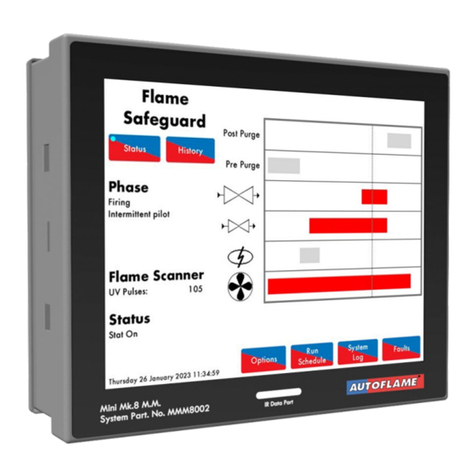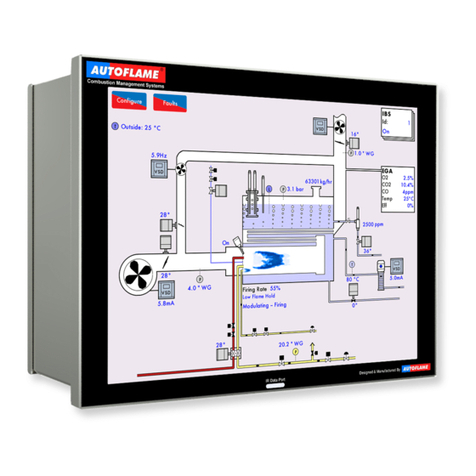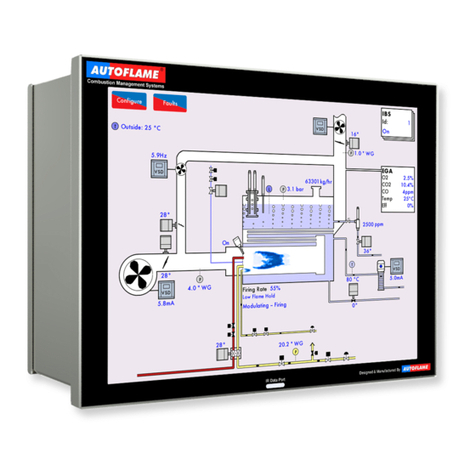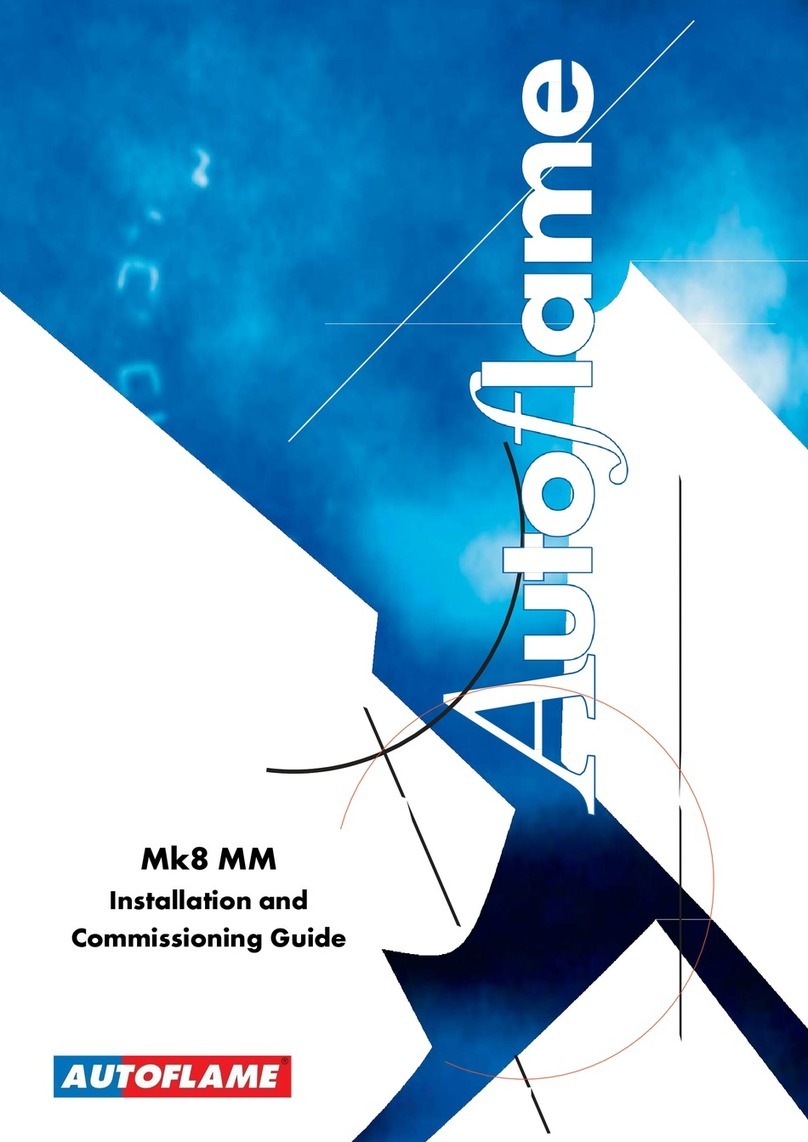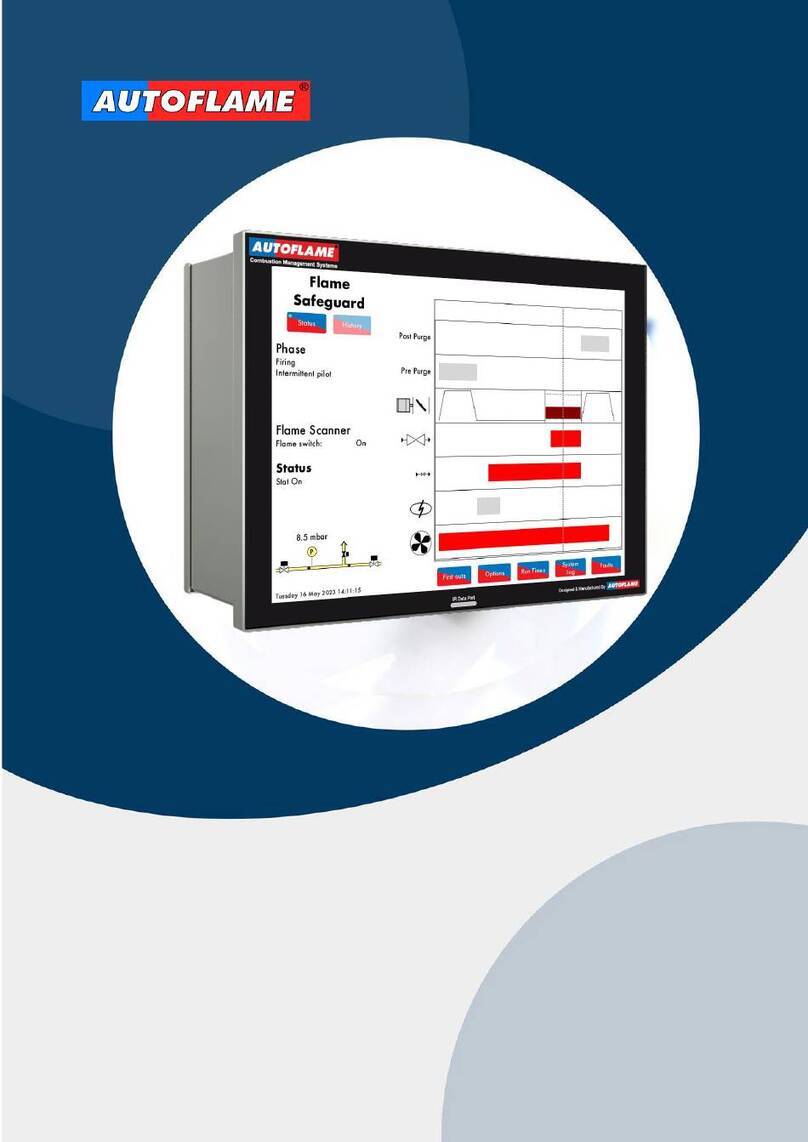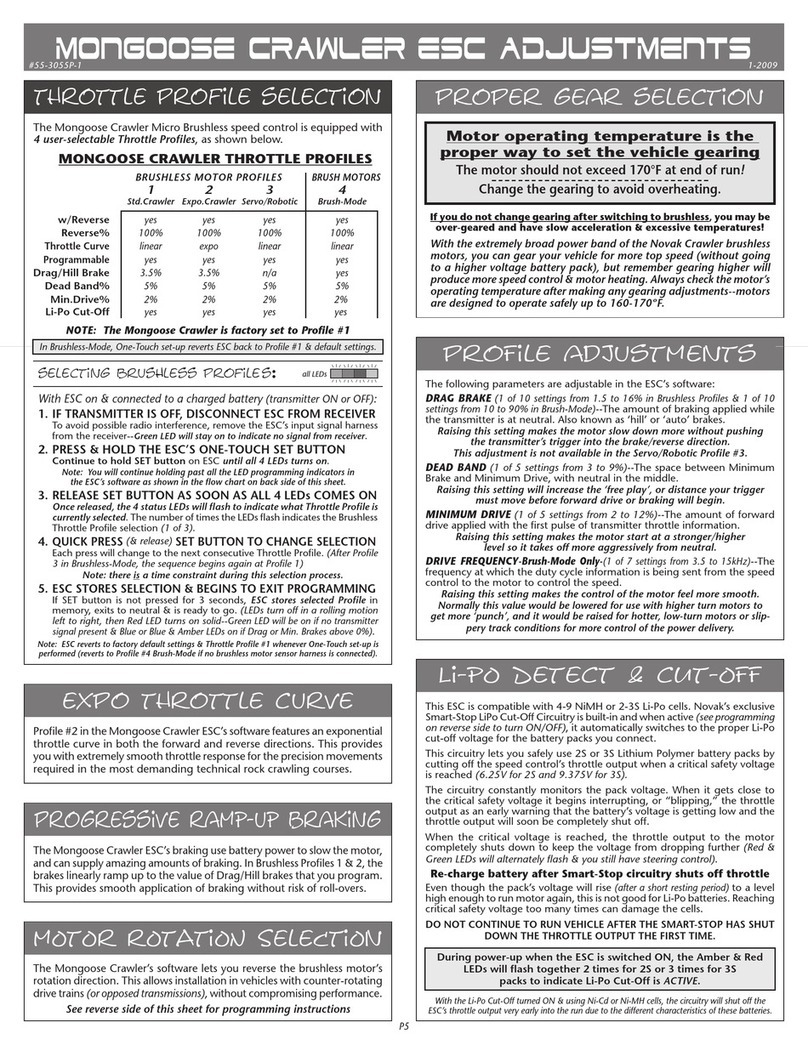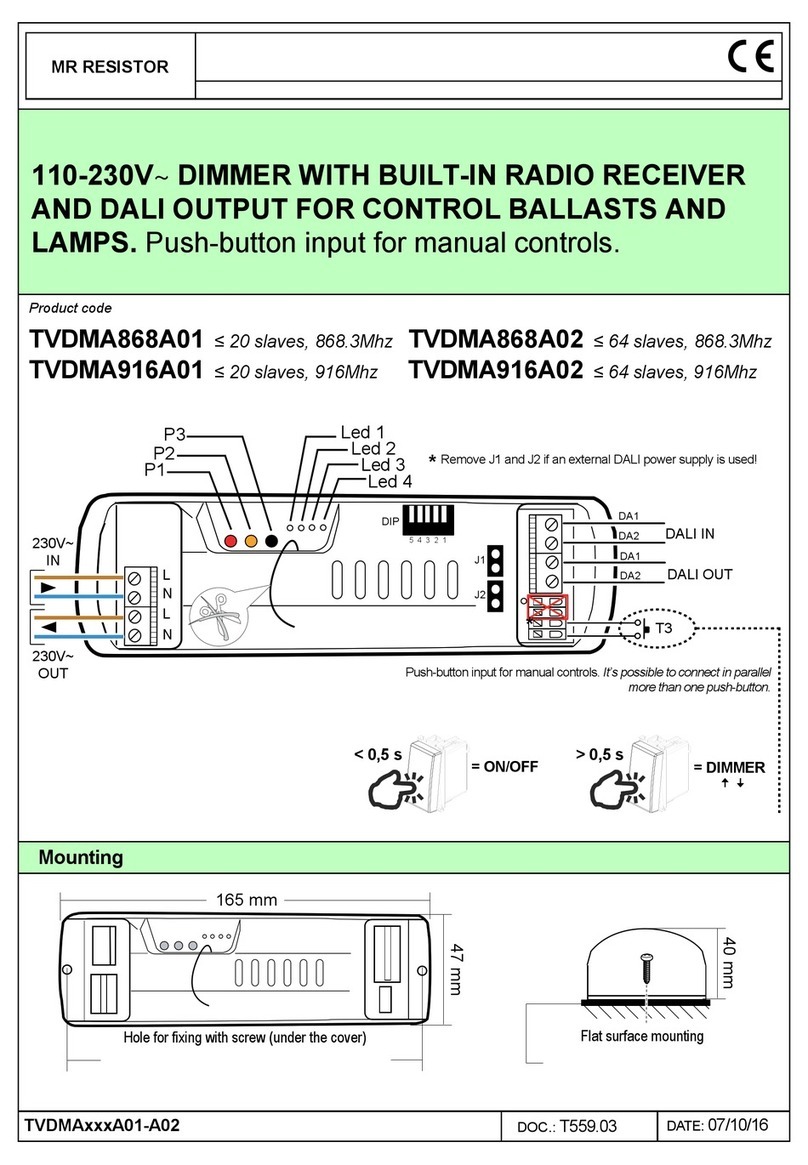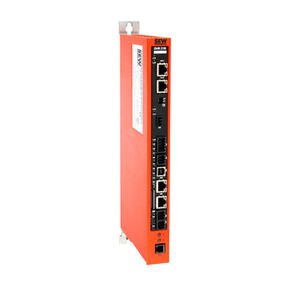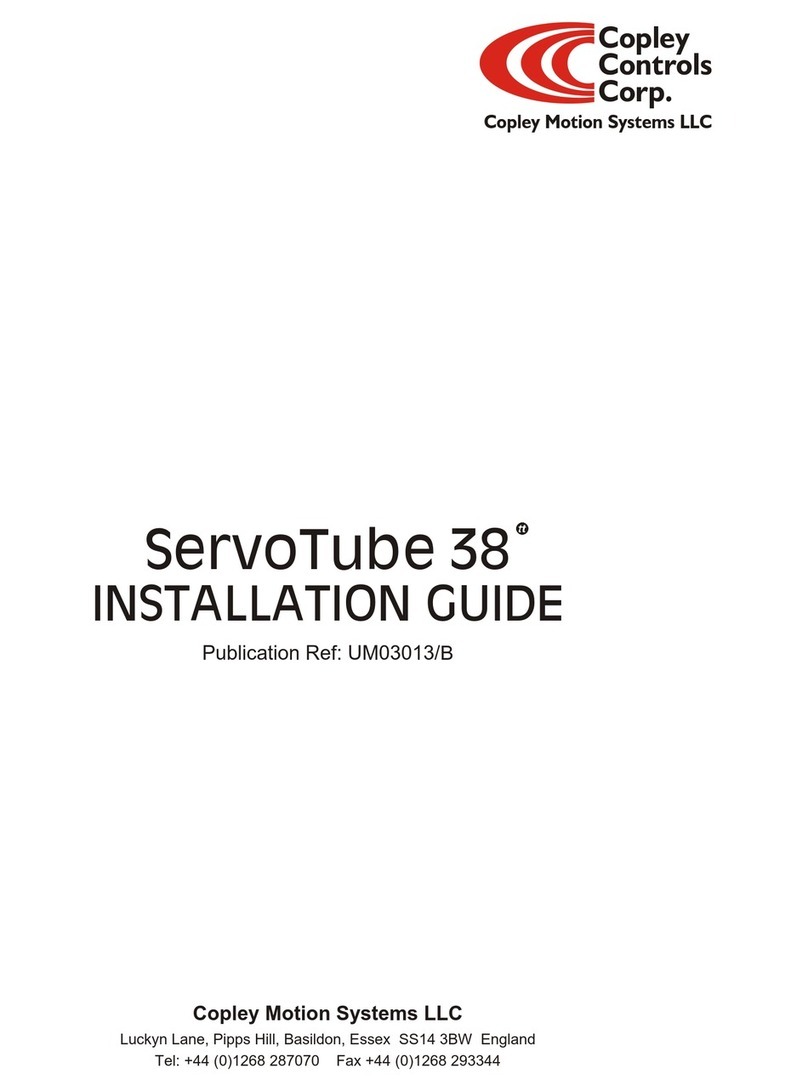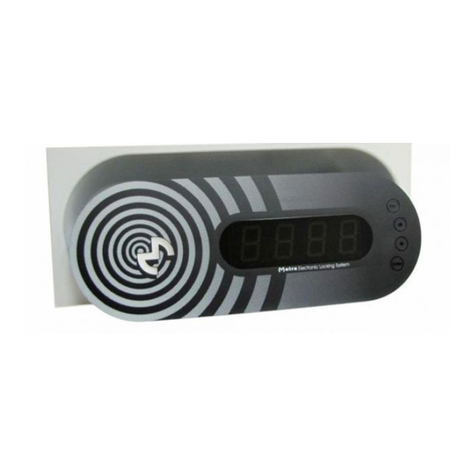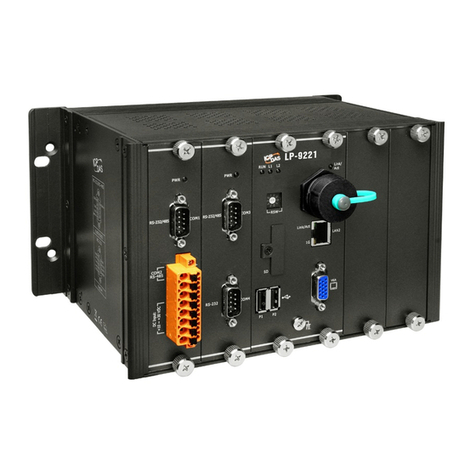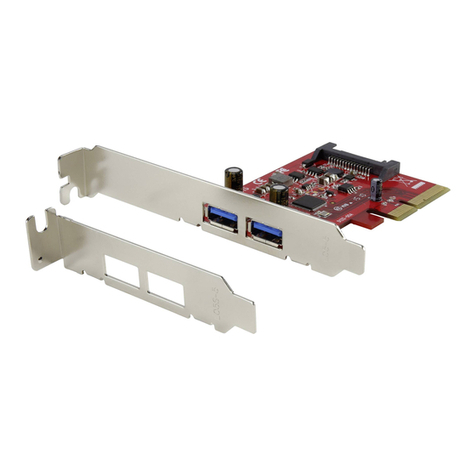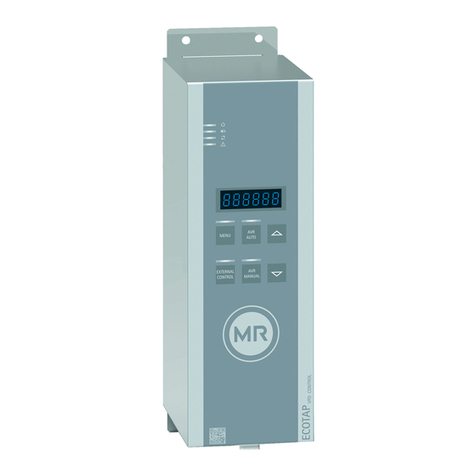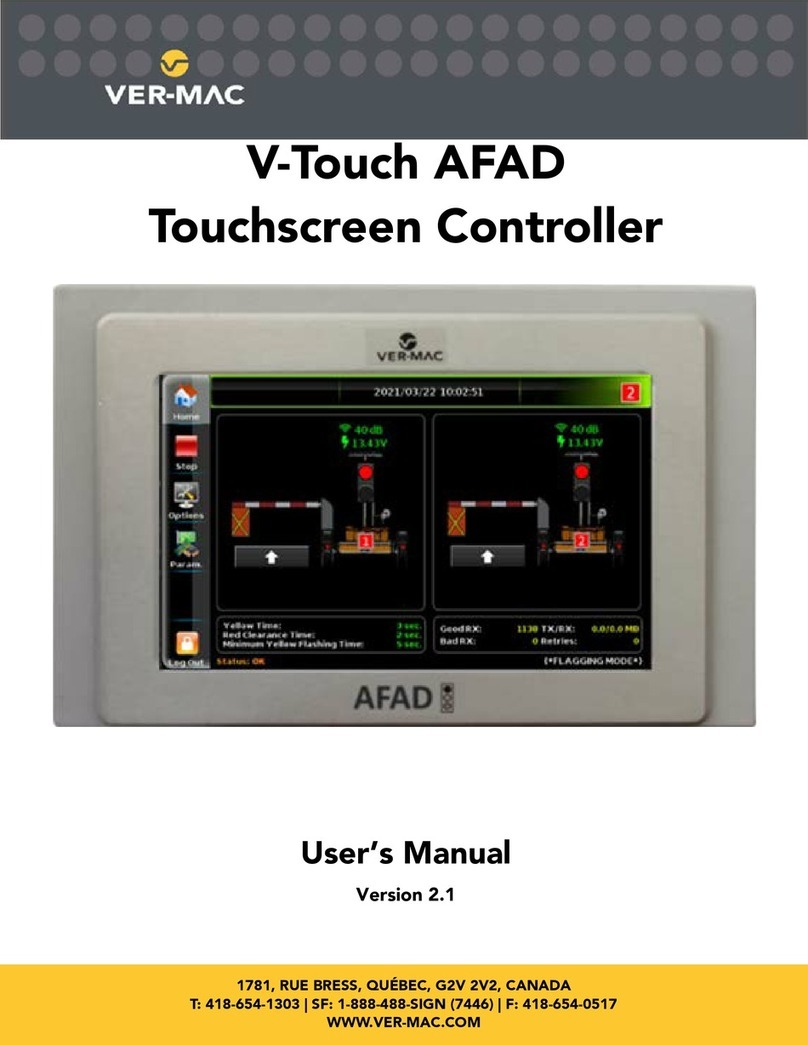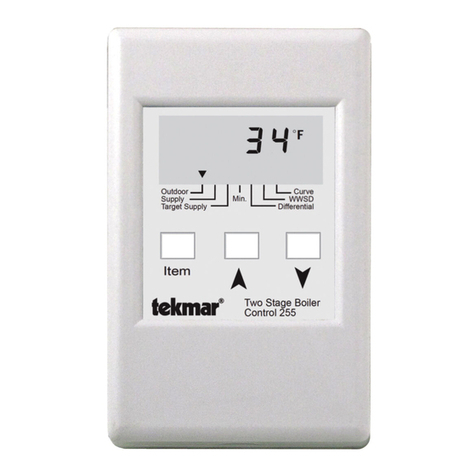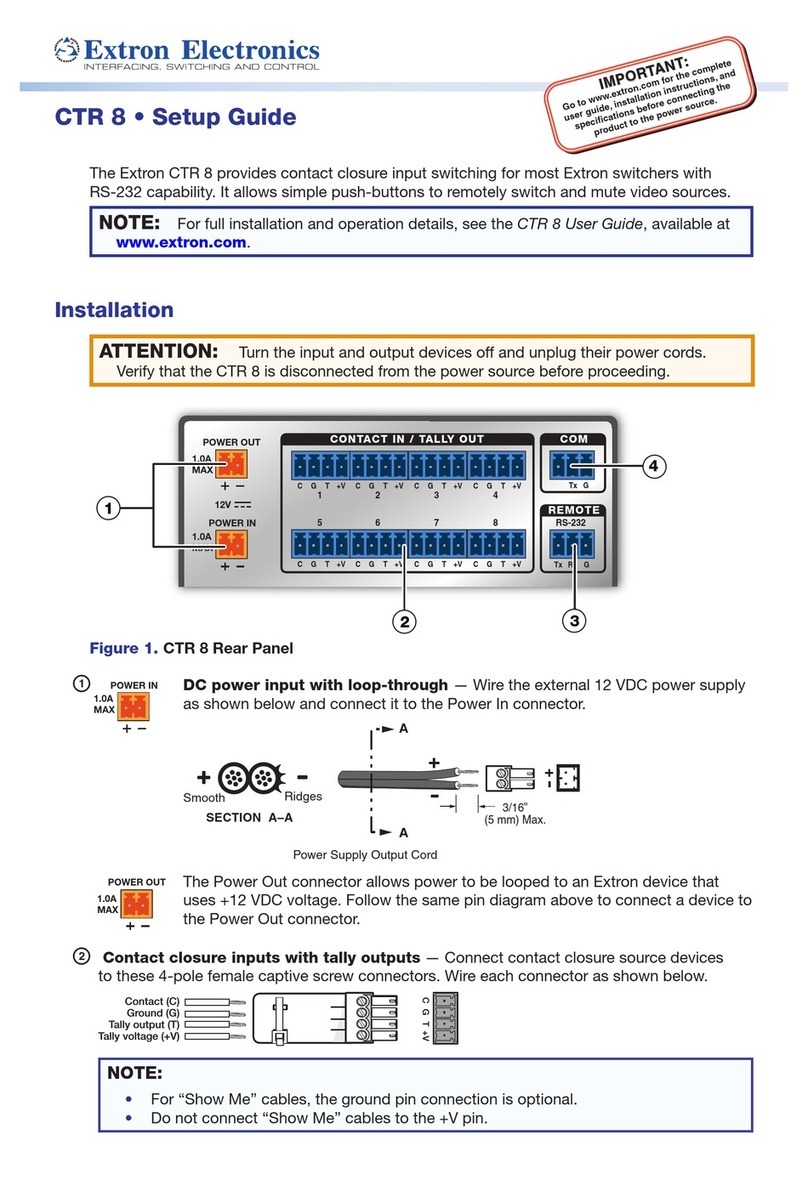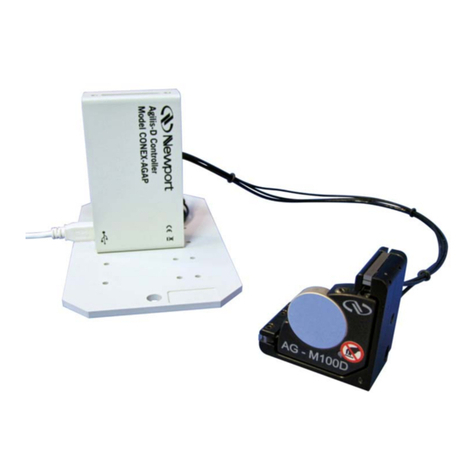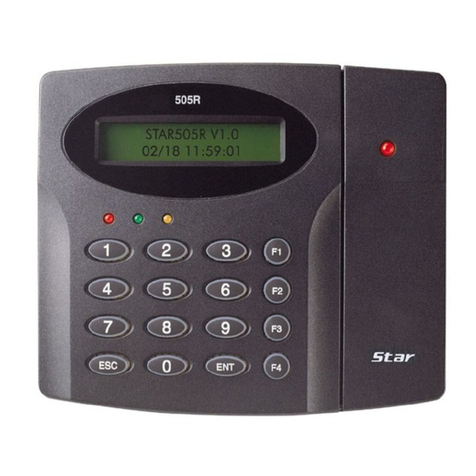AUTOFLAME Mk8 MM User manual

MK8 MM MANUAL
MM80001
19.05.2020
MK8 MM MANUAL
MM80001
Combustion Management Systems
19 MAY 2020

Autoflame Engineering Ltd.
Unit 1-2 Concorde Business Centre
Airport Industrial Estate
Wireless Road, Biggin Hill
Kent TN16 3YN
United Kingdom
COMBUSTION MANAGEMENT SYSTEMS
+44 (0)1959 578 820
Tel:
technicalsupport@autoflame.com
Email:
www.autoflame.com
Web:
MK8 MM MANUAL
MM80001
19 MAY 2020
This manual and all the information contained herein is copyright of Autoflame Engineering Ltd. It may not be
copied in the whole or part without the consent of the Managing Director.
Autoflame Engineering Ltd’s policy is one of continuous improvement in both design and manufacture. We
therefore reserve the right to amend specifications and/or data without prior notice. All details contained in
this manual are correct at the time of going to print.

Important Notes
A knowledge of combustion related procedures and commissioning is essential before embarking work on
any of the MM / EGA systems. This is for safety reasons and effective use of the MM / EGA system. Hands
on training is required. For details on schedules and fees relating to group training courses and individual
instruction, please contact the Autoflame Engineering Ltd. offices at the address listed on the front.
Short Form - General Terms and Conditions
A full statement of our business terms and conditions are printed on the reverse of all invoices. A copy of
these can be issued upon application, if requested in writing.
The System equipment and control concepts referred to in this Manual MUST be installed, commissioned
and applied by personnel skilled in the various technical disciplines that are inherent to the Autoflame
product range, i.e. combustion, electrical and control.
The sale of Autoflame’s systems and equipment referred to in this Manual assume that the dealer, purchaser
and installer has the necessary skills at his disposal. i.e. A high degree of combustion engineering
experience, and a thorough understanding of the local electrical codes of practice concerning boilers,
burners and their ancillary systems and equipment.
Autoflame’s warranty from point of sale
•Two years on all electronic systems and components.
•One year on all mechanical systems, components and sensors.
The warranty assumes that all equipment supplied will be used for the purpose that it was intended and in
strict compliance with our technical recommendations.
Autoflame’s warranty and guarantee is limited strictly to product build quality, and design. Excluded
absolutely are any claims arising from misapplication, incorrect installation and/or incorrect commissioning.

CONTENTS
1MK8 MM OVERVIEW, SPECIFICATIONS AND WIRING ........................................................... 13
1.1 Mk8 MM Overview ........................................................................................................................... 13
1.1.1 Mk8 MM Main Features ........................................................................................................... 14
1.1.2 Overview of Micro-Modulation (MM)........................................................................................ 15
1.1.3 Fixing Holes and Dimensions .................................................................................................. 16
1.2Wiring Schematic............................................................................................................................. 17
1.2.1 Main Board............................................................................................................................... 17
1.2.2 Expansion Board ..................................................................................................................... 18
1.2.3 Fuse Ratings............................................................................................................................ 19
1.3 Electrical Specifications ................................................................................................................... 20
1.3.1 MM Inputs and Outputs ........................................................................................................... 20
1.3.2 Expansion Board Inputs and Outputs...................................................................................... 21
1.3.3 Cable Specifications ................................................................................................................ 22
1.3.4 MM Terminals Description ....................................................................................................... 23
1.3.5 Expansion Board Terminals Description ................................................................................. 26
1.4 Connection Between Mk8 MM and Mk8 EGA EVO ........................................................................ 29
1.5 Connection Between Mk8 MM and Mk8 DTI ................................................................................... 30
1.6 Sequencing Connection Diagram .................................................................................................... 31
1.7 Standards......................................................................................................................................... 32
2OPTIONS AND PARAMETERS................................................................................................... 33
2.1 Options............................................................................................................................................. 33
2.2 Parameters ...................................................................................................................................... 57
3COMMISSIONING PROCEDURE................................................................................................ 67
3.1 Overview .......................................................................................................................................... 67
3.2 Installation Checks........................................................................................................................... 68
3.2.1 Commissioning Checks ........................................................................................................... 68
3.2.2 Operational Checks ................................................................................................................. 68
3.2.3 Installation Precautions............................................................................................................ 68
3.2.4 Maintenance and Servicing ..................................................................................................... 68
3.3 Servomotors..................................................................................................................................... 69
3.3.1 Adjusting the Servomotor Potentiometer ................................................................................. 69
3.3.2 Servomotor Feedback Voltage ................................................................................................ 70
3.3.3 Servomotors – Direction Change............................................................................................. 70
3.3.4 Servomotors with Autoflame Valves ........................................................................................ 71
3.4 Commissioning Fuel and Air Positions ............................................................................................ 72
3.4.1 Starting Commissioning........................................................................................................... 73
3.4.2 Enter CLOSED Position........................................................................................................... 74
3.4.3 Enter OPEN Position ............................................................................................................... 75
3.4.4 Set up START Position............................................................................................................ 76
3.4.5 Phase Hold .............................................................................................................................. 77
3.4.6 Add Trim Data During Commissioning .................................................................................... 78
3.4.7 Commissioning VSD................................................................................................................ 80
3.4.8 Set GOLDEN START Position................................................................................................. 81
3.4.9 Set FGR Position ..................................................................................................................... 83
3.4.10 Set HIGH Position.................................................................................................................... 85
3.4.11 Set INTER Position .................................................................................................................. 86

3.4.12 Set INTER or START Position................................................................................................. 87
3.4.13 Save Commission .................................................................................................................... 88
3.5 Fuel Flow Metering .......................................................................................................................... 89
3.5.1 Commissioning Fuel Flow Through MM .................................................................................. 89
3.5.2 Commissioning Fuel Flow Through 4-20mA Feedback .......................................................... 91
3.5.3 Calorific Fuel Data ................................................................................................................... 92
3.5.4 Conversion Factor for Imperial Gas Flow Meters .................................................................... 93
3.5.5 Correction Factor for Burners Significantly Above Sea Level ................................................. 93
3.5.6 Gas Volume Conversion Factors............................................................................................. 94
3.6 Gas/ Air Pressure Commission........................................................................................................ 96
3.7 Single Point Change ........................................................................................................................ 97
3.8 Online Changes ............................................................................................................................. 102
3.9 Setpoint Schedule.......................................................................................................................... 103
3.9.1 Setpoint Schedule Overview.................................................................................................. 103
3.9.2 Configuring Setpoint Schedule .............................................................................................. 103
4FUEL OUTPUT MODES & CHANGEOVER OPTIONS ............................................................ 106
4.1 Overview ........................................................................................................................................ 106
4.2 Fuel Output Modes on the Mk8 MM .............................................................................................. 107
4.3 Single Fuel Output Mode (SFOM) ................................................................................................. 108
4.3.1 Fuel Configuration and Wiring in SFOM ................................................................................ 108
4.3.2 Pressure Sensors in SFOM ................................................................................................... 108
4.3.3 Commissioning in SFOM ....................................................................................................... 108
4.3.4 Fuel Changeover Process in SFOM ...................................................................................... 108
4.4 Dual Fuel Output Mode (DFOM) ................................................................................................... 109
4.4.1 Fuel Configuration and Wiring in DFOM................................................................................ 109
4.4.2 Pressure Sensors in DFOM................................................................................................... 109
4.4.3 Commissioning in DFOM....................................................................................................... 110
4.4.4Fuel Changeover Process in Dual Fuel Output Mode ........................................................... 110
4.5 Fuel Change on the Fly (COF) ...................................................................................................... 112
4.5.1 Overview ................................................................................................................................ 112
4.5.2 Checks before COF can take place....................................................................................... 113
4.5.3 COF Changeover Position..................................................................................................... 113
4.5.4 COF Fuel Changeover........................................................................................................... 114
4.5.5 Checks after COF Fuel Changeover ..................................................................................... 115
4.5.6 Continuous Pilot with COF..................................................................................................... 116
4.6 Gas Pressure Sensors and Valve Proving in DFOM with COF..................................................... 118
4.7 Limitations of DFOM and COF ...................................................................................................... 119
5PID CONTROL ........................................................................................................................... 120
5.1 Proportional Band .......................................................................................................................... 120
5.2 Integral Control .............................................................................................................................. 121
5.3 Derivative Control .......................................................................................................................... 122
6MM FEATURES ......................................................................................................................... 123
6.1 Firing Rate Control......................................................................................................................... 123
6.1.1 Hand Operation...................................................................................................................... 123
6.1.2 Low Flame Hold ..................................................................................................................... 123
6.1.3 Auto Operation....................................................................................................................... 123
6.2 Using 4-20mA Servomotors........................................................................................................... 125
6.2.1 Overview ................................................................................................................................ 125
6.2.2 External 4-20mA Servomotor Requirements ......................................................................... 125

6.2.3 Wiring..................................................................................................................................... 126
6.2.4 Settings .................................................................................................................................. 127
6.2.5 Commissioning ...................................................................................................................... 127
6.3 Flame Detection Using Flame Switch............................................................................................ 128
6.4 Continuous Pilot............................................................................................................................. 129
6.4.1 Continuous Pilot with Interrupted Pilot Sequence ................................................................. 130
6.4.2 Continuous Pilot with Intermittent Pilot Sequence................................................................. 131
6.5 Load Sensor Value Calibration ...................................................................................................... 132
6.6 External Modulation ....................................................................................................................... 133
6.7 External Setpoint ........................................................................................................................... 133
6.8 Second Setpoint Select ................................................................................................................. 133
6.9 Start Position Interlock and Purge Position Interlock .................................................................... 134
6.10 Purge Pressure Proving/ Purge Hold ............................................................................................ 135
6.11 No Pre-Purge ................................................................................................................................. 136
7INTELLIGENT BOILER SEQUENCING .................................................................................... 137
7.1 Sequencing Schematics ................................................................................................................ 137
7.1.1 Hot Water Example................................................................................................................ 138
7.1.2 Single/ Multi-Burner Examples .............................................................................................. 139
7.1.3 IBS Communications ............................................................................................................. 140
7.2 Sequencing Options and Parameters............................................................................................ 141
7.3 Hot Water Sequencing................................................................................................................... 142
7.3.1 Implementing Hot Water Sequencing .................................................................................... 142
7.3.2 Two Port Valve Operation...................................................................................................... 143
7.4 Steam Sequencing ........................................................................................................................ 144
7.4.1 Warming Steam Boilers ......................................................................................................... 144
7.4.2 Implementing Steam Sequencing.......................................................................................... 144
7.4.3 Low Pressure Steam Sequencing ......................................................................................... 145
7.5 Troubleshooting – Sequencing ...................................................................................................... 146
8MULTI-BURNER OPERATION.................................................................................................. 147
8.1 Multi-Burner Overview ................................................................................................................... 147
8.2 Configuring Multi-Burner Operation ............................................................................................... 148
8.2.1 Wiring..................................................................................................................................... 148
8.2.2 Options and Parameters........................................................................................................ 149
8.2.3Commissioning in Multi-Burner Operation............................................................................. 149
8.2.4 Fuel Flow Metering in Multi-Burner Operation....................................................................... 149
8.2.5 Single Point Change in Multi-Burner Operation..................................................................... 149
8.3 Multi-Burner Operation Options ..................................................................................................... 150
8.3.1 Fully Linked Operation........................................................................................................... 150
8.3.2 Independent on Fault............................................................................................................. 151
8.4 Multi-Burner with Water Level Control........................................................................................... 152
8.5 Multi-Burner with EGA ................................................................................................................... 153
8.5.1 Multi-Burner with Single EGA ................................................................................................ 153
8.5.2 Multi-Burner with individual EGAs ......................................................................................... 154
8.6 Multi-Burner External Modulation .................................................................................................. 155
8.6.1 Permanent External Modulation ............................................................................................ 155
8.6.2 Switched External Modulation ............................................................................................... 155
9EXPANSION FEATURES .......................................................................................................... 156

10 WATER LEVEL CONTROL ....................................................................................................... 157
10.1 Overview ........................................................................................................................................ 157
10.1.1 Safety..................................................................................................................................... 157
10.1.2 Autoflame Water Level Control.............................................................................................. 157
10.1.3 Water Treatment .................................................................................................................... 158
10.2 Water Level Control Expansion Options........................................................................................ 159
10.3 Water Valves ................................................................................................................................. 165
10.3.1 Specifications......................................................................................................................... 165
10.3.2 Feed Water Valve Sizing ....................................................................................................... 166
10.3.3 Feed Water Control ............................................................................................................... 167
10.4 Ways of Level Sensing .................................................................................................................. 168
10.4.1 Overview ................................................................................................................................ 168
10.4.2 Configuration.......................................................................................................................... 169
10.5 Capacitance Probes ...................................................................................................................... 172
10.5.1 Overview ................................................................................................................................ 172
10.5.2 Operation ............................................................................................................................... 173
10.5.3 Specification........................................................................................................................... 173
10.5.4 Installation Safety Guidelines ................................................................................................ 175
10.5.5 Configuration.......................................................................................................................... 180
10.5.6 Capacitance Probes Maintenance......................................................................................... 180
10.6 2nd Low Probe ................................................................................................................................ 181
10.6.1 Overview ................................................................................................................................ 181
10.6.2 Operation ............................................................................................................................... 181
10.6.3 Specifications......................................................................................................................... 181
10.6.4 Installation and Safety Guidelines ......................................................................................... 183
10.6.5 Configuration.......................................................................................................................... 184
10.7 Analogue Water Level ................................................................................................................... 185
10.8 Auxiliary Alarm Inputs .................................................................................................................... 186
10.9 Commissioning Procedure............................................................................................................. 187
10.9.1 Commissioning Checks ......................................................................................................... 187
10.9.2 Levels..................................................................................................................................... 187
10.9.3 Setting End of Probe Level .................................................................................................... 188
10.9.4 Setting 2nd Low Level............................................................................................................. 190
10.9.5 Setting 1st Low Level.............................................................................................................. 191
10.9.6 Setting Control Point Level .................................................................................................... 192
10.9.7 Setting HIGH Level ................................................................................................................ 193
10.9.8 Save Commissioning ............................................................................................................. 194
10.9.9 Operational Checks ............................................................................................................... 196
10.9.10 Adjust Control Point ........................................................................................................... 197
10.10 Water Level Control Functions .................................................................................................. 198
10.10.1 Pre-Alarms ......................................................................................................................... 198
10.10.2 Pump Bypass..................................................................................................................... 198
10.10.3 Test Outputs and Shunt Switch ......................................................................................... 199
10.10.4 Sudden Pressure Drop ...................................................................................................... 200
10.11 Faults ......................................................................................................................................... 201
11 TOP BLOWDOWN ..................................................................................................................... 204
11.1 Overview ........................................................................................................................................ 204
11.1.1 Importance of Maintaining TDS ............................................................................................. 204
11.1.2 TDS, Conductivity and Temperature ..................................................................................... 205
11.2 Top Blowdown Expansion Options ................................................................................................ 206

11.3 TDS Valves .................................................................................................................................... 209
11.4 TDS Probe ..................................................................................................................................... 210
11.4.1 Specification........................................................................................................................... 210
11.4.2 Dimensions ............................................................................................................................ 211
11.4.3 Installation.............................................................................................................................. 212
11.5 Configuration ................................................................................................................................. 213
11.5.1 Wiring..................................................................................................................................... 213
11.5.2 Top Blowdown PID Controller................................................................................................ 213
11.6 Ways of Controlling TDS Level...................................................................................................... 214
11.6.1 Continuous TDS Control........................................................................................................ 214
11.6.2 Solenoid and Servomotor 2-State TDS Control..................................................................... 214
11.6.3 TDS Timing Diagram ............................................................................................................. 215
11.6.4 Sample Routine ..................................................................................................................... 216
11.7 Water Hardness Monitoring ........................................................................................................... 217
11.8 Calibrating the TDS Probe............................................................................................................. 218
11.9 Faults ............................................................................................................................................. 220
12 BOTTOM BLOWDOWN............................................................................................................. 221
12.1 Overview ........................................................................................................................................ 221
12.2 Bottom Blowdown Expansion Options........................................................................................... 222
12.3 Bottom Blowdown Reduction......................................................................................................... 223
12.3.1 Blowdown Energy Savings .................................................................................................... 223
12.3.2 Calculation for Bottom Blowdown Reduction......................................................................... 224
12.4 Installation Guidance ..................................................................................................................... 226
12.4.1 Bottom Blowdown Valve ........................................................................................................ 227
12.4.2 Bottom Blowdown Using Solenoid Valve............................................................................... 227
12.4.3 Bottom Blowdown Module ..................................................................................................... 228
12.5 Set-up ............................................................................................................................................ 230
12.5.1 Bottom Blowdown Settings .................................................................................................... 230
12.5.2 Setting Servomotor ................................................................................................................ 231
12.6 Bottom Blowdown Configuration ................................................................................................... 235
12.6.1 Bottom Blowdown Schedule .................................................................................................. 235
12.6.2 Bottom Blowdown Log ........................................................................................................... 237
12.7 Faults ............................................................................................................................................. 238
13 DRAUGHT CONTROL ............................................................................................................... 239
13.1 Overview of Draught Control ......................................................................................................... 239
13.1.1 Parts Required for Draught Control ....................................................................................... 241
13.2 Draught Control Expansion Options .............................................................................................. 242
13.3 Draught Control Operation............................................................................................................. 244
13.3.1 Operation Overview ............................................................................................................... 244
13.3.2 Deactivation Window ............................................................................................................. 245
13.3.3 Draught Control Trim ............................................................................................................. 246
13.4 Draught Control Set-Up ................................................................................................................. 248
13.4.1 Configuration.......................................................................................................................... 248
13.4.2 Ways of Using Draught Servomotor ...................................................................................... 249
13.5 Commissioning Draught Control.................................................................................................... 250
13.5.1 Commissioning Checks ......................................................................................................... 250
13.5.2 Commissioning Screen.......................................................................................................... 251
13.6 Faults ............................................................................................................................................. 252

14 DIRECT MODBUS ..................................................................................................................... 253
14.1 Overview ........................................................................................................................................ 253
14.2 Direct Modbus Expansion Options ................................................................................................ 254
14.3 Setup and Configuration ................................................................................................................ 255
14.4 Modbus Addresses ........................................................................................................................ 256
15 FIRST OUTS............................................................................................................................... 264
15.1 Overview of Firs Outs .................................................................................................................... 264
15.2 First Outs Expansion Options ........................................................................................................ 264
15.3 First Outs Configuration................................................................................................................. 265
15.3.1 Enabling First Outs ................................................................................................................ 265
15.3.2 Running Interlock Circuit........................................................................................................ 265
15.3.3 Accessing First Outs.............................................................................................................. 266
15.3.4 First Out Function .................................................................................................................. 267
15.3.5 Edit First Out Label ................................................................................................................ 268
15.3.6 First Outs Interlock................................................................................................................. 269
16 HEAT FLOW............................................................................................................................... 270
16.1 Overview ........................................................................................................................................ 270
16.2 Expansion Options......................................................................................................................... 271
16.3 Wiring............................................................................................................................................. 273
16.4 Heat Flow Function........................................................................................................................ 274
16.5 Steam Flow Metering..................................................................................................................... 279
16.5.1 Steam Flow Calculation ......................................................................................................... 279
16.5.2 Steam Flow ............................................................................................................................ 283
16.5.3 Steam Flow with Economiser ................................................................................................ 284
16.5.4 Steam Flow with Deaerator ................................................................................................... 285
16.5.5 Steam Flow with Deaerator and Feed Sensor....................................................................... 286
16.6 Hot Water Flow Metering ............................................................................................................... 287
16.6.1 Hot Water Flow Calculation ................................................................................................... 287
16.6.2 Hot Water Flow ...................................................................................................................... 289
16.6.3 Hot Water Flow with Economiser........................................................................................... 290
16.7 Spare Temperature Sensor ........................................................................................................... 291
16.7.1 Configuration Options ............................................................................................................ 291
16.7.2 Spare Temperature Sensor Terminal .................................................................................... 291
16.7.3 Exhaust Temperature Shutdown Threshold .......................................................................... 293
16.8 Faults ............................................................................................................................................. 294
17 FULLY METERED COMBUSTION CONTROL ......................................................................... 295
17.1 Overview ........................................................................................................................................ 295
17.1.1 Introduction ............................................................................................................................ 295
17.1.2 Importance of Excess Air....................................................................................................... 295
17.2 Fully Metered Control Expansion Options ..................................................................................... 296
17.3 Fully Metered Combustion Control Operation ............................................................................... 300
17.3.1 Philosophy ............................................................................................................................. 300
17.3.2 Firing Rate ............................................................................................................................. 300
17.3.3 Control Process ..................................................................................................................... 301
17.3.4 Mass Flow Meters.................................................................................................................. 302
17.3.5 Volume Flow Meters .............................................................................................................. 302
17.4 Set-Up............................................................................................................................................ 303
17.4.1 Configuration.......................................................................................................................... 303

17.4.2 Limitations.............................................................................................................................. 304
17.4.3 Commissioning ...................................................................................................................... 305
17.5 Faults ............................................................................................................................................. 308
18 OPERATION............................................................................................................................... 309
18.1 Home Screen................................................................................................................................. 309
18.1.1 Home Screen Components ................................................................................................... 310
18.1.2 Faults ..................................................................................................................................... 312
18.2 Status Screen ................................................................................................................................ 313
18.2.1 Status..................................................................................................................................... 313
18.2.2 Status – History...................................................................................................................... 314
18.2.3 Status – Burner Enable/Disable............................................................................................. 315
18.2.4 Status – Low Flame Hold....................................................................................................... 316
18.2.5 Status – Hand Mode .............................................................................................................. 317
18.3 Fuel-Air Screen.............................................................................................................................. 318
18.3.1 Fuel-Air – Curve..................................................................................................................... 318
18.3.2 Fuel-Air – Map ....................................................................................................................... 319
18.3.3 Fuel-Air – History ................................................................................................................... 320
18.4 Flame Safeguard Screen............................................................................................................... 321
18.4.1 Flame Safeguard ................................................................................................................... 321
18.4.2 Flame Safeguard – History .................................................................................................... 322
18.5 Channels Screen ........................................................................................................................... 323
18.5.1 Servomotor ............................................................................................................................ 323
18.5.2 VSD Channel ......................................................................................................................... 324
18.6 Gas Pressure Sensor Screen ........................................................................................................ 325
18.6.1 Gas Pressure ......................................................................................................................... 325
18.6.2 Gas Sensor – History............................................................................................................. 326
18.7 Air Pressure Sensor Screen .......................................................................................................... 327
18.7.1 Air Pressure ........................................................................................................................... 327
18.7.2 Air Sensor – History............................................................................................................... 328
18.8 Fuel Flow Screen ........................................................................................................................... 329
18.8.1 Fuel Flow ............................................................................................................................... 329
18.8.2 Fuel Flow – History ................................................................................................................ 330
18.9 Sequencing Screen ....................................................................................................................... 331
18.9.1 IBS – Status ........................................................................................................................... 331
18.9.2 3.9.2 IBS – Lead Boiler .......................................................................................................... 332
18.9.3 IBS – History .......................................................................................................................... 333
18.10 EGA Screen ............................................................................................................................... 334
18.10.1 EGA – Gas......................................................................................................................... 334
18.10.2 EGA – Temperature........................................................................................................... 335
18.10.3EGA – Efficiency................................................................................................................ 336
18.11 Outside Temperature Compensation Screen ............................................................................ 337
18.12 Water Level Screen ................................................................................................................... 338
18.12.1 Water Level – Status ......................................................................................................... 338
18.12.2 Water Level – History ........................................................................................................ 339
18.13 Top Blowdown Screen ............................................................................................................... 340
18.14 Bottom Blowdown Screen.......................................................................................................... 342
18.15 Steam Flow Screen ................................................................................................................... 343
18.15.1 Steam Flow – Status.......................................................................................................... 343
18.15.2 Steam Flow – History......................................................................................................... 344
18.16 Draught Screen.......................................................................................................................... 345

18.16.1 Draught Control – Status ................................................................................................... 345
18.16.2 Draught Control – History .................................................................................................. 346
18.17 First Outs ................................................................................................................................... 347
18.18 Fully Metered Combustion Control ............................................................................................ 348
18.19 System Configuration Screen .................................................................................................... 349
18.19.1 Language Selection ........................................................................................................... 350
18.19.2Options............................................................................................................................... 351
18.19.3 Parameters ........................................................................................................................ 352
18.19.4 Expansion Options............................................................................................................. 353
18.19.5Boiler Room Configuration................................................................................................. 354
18.19.6 Online Changes ................................................................................................................. 361
18.19.7 Set Clock............................................................................................................................ 362
18.19.8 Run Times.......................................................................................................................... 363
18.19.9 Bottom Blowdown Schedule .............................................................................................. 366
18.19.10 Manual ............................................................................................................................... 367
18.19.11 Commission Data .............................................................................................................. 368
18.19.12 Diagnostics ........................................................................................................................ 369
18.19.13 System Log ........................................................................................................................ 370
19 ERRORS AND LOCKOUTS ...................................................................................................... 371
19.1 Errors ............................................................................................................................................. 371
19.2 Lockouts......................................................................................................................................... 375
19.3 Alarms and Warnings .................................................................................................................... 380
19.4 Settings Conflicts ........................................................................................................................... 388
19.5 Forced Commission Reasons........................................................................................................ 393

1 Mk8 MM Overview, Specifications and Wiring
Mk8 MM Manual Page | 12
VERY IMPORTANT SAFETY NOTES
Please fully read and understand the following notes before commencing
with any work related to the Mk8 MM. Failing to do so can result in
serious injury or even death, and can cause serious equipment and
property damage.
Any person working on a boiler must be adequately trained and have a thorough
understanding and appreciation of the boiler plant.
It is the responsibility of the technician working on the plant to ensure that the
system operation meets all local codes and regulations.
Options, Parameters and Expansion Options must only be changed by an
Autoflame-trained and certified technician who has thorough understanding of the
Autoflame combustion control systems and boiler/combustion control in general.
Any person changing these settings without undergoing the necessary training and
gaining understanding of the boiler plant may place themselves and others in a
potentially dangerous situation or cause permanent equipment damage.
Modification to the Autoflame system settings should only ever be carried out by
qualified combustion engineers. Changes to the Autoflame control system setup
has the potential to make the controller operate in an unstable and potentially
unsafe manner.
Commissioning or burner start-up must only be carried out by a an Autoflame-
trained and certified technician.
The commissioning procedure as described must be strictly adhered to. Anybody
commissioning an Autoflame system must be trained in operating combustion
equipment safely.
Autoflame products must only be installed, set up, commissioned and adjusted by
an Autoflame certified technician.
The fundamental idea of the system is to set a fuel valve position and then set a
corresponding air damper position. Care must be taken when adjusting the fuel and
air positions so as not to create any unstable or hazardous combustion conditions,
e.g. moving the fuel valve to the open position without increasing the air damper
position. Improper use may result in property damage, serious physical injury or
death.
Electrical connections are live, incorrect application may result in serious physical
injury or death.
If you are unclear about anything related to the Autoflame system, please contact
Autoflame for technical advice.

1 Mk8 MM Overview, Specifications and Wiring
Mk8 MM Manual Page | 13
1MK8 MM OVERVIEW, SPECIFICATIONS AND WIRING
1.1 Mk8 MM Overview
The Mk8 MM Controller is a Micro-Modulating system that offers comprehensive control over industrial and
commercial boiler/burners.
With the Mk8 MM, it is possible to control all boiler processes from a single 12.1” multi-touch screen interface
without any added module. It is ideal for steam and water boilers (watertube or firetube), kilns and steam
generators. Designed for oil, natural gas or both fuel, the MM features linkageless servomotor system and
automated flame safeguard create conditions for unmanned boiler house.
Additional expansion features include:
•Autoflame water level management
•Analogue water level using third party water level detection system
•TDS/Top blowdown
•Bottom blowdown
•Draught control
•Direct Modbus connectivity
•First out annunciation
•Fully metered, cross-limited control
•Steam flow & hot water flow metering
•Modbus connectivity allows for remote monitoring and management
•Setpoint scheduling
•Fuel change on the fly

1 Mk8 MM Overview, Specifications and Wiring
Mk8 MM Manual Page | 14
1.1.1 Mk8 MM Main Features
•Fuel/Air ratio control
•12.1” Full colour touch screen
•120V or 230V standard operation 50/60Hz
•Controls up to 5 servomotors and 2 variable speed drives (VSD/ VFD)
•4 independent fuel programmes
•Fully adjustable PID load control for temperature or pressure
•Internal flame safeguard – full flame supervision with self-check UV or IR
•Dual flame scanner operation (IR and UV scanners)
•Gas valve train leak supervision and high/low gas pressure monitoring
•Air pressure proving and monitoring
•128 lockouts, errors, alarms and warnings stored with date, time, phase and reset
•1000 entry system log stored with date, time and status
•Online diagnostics showing system electronics information
•Single point change for adding, removing and adjusting fuel/air positions on fuel-air curve
•Golden start position for optimum ignition position
•Flue gas recirculation start position
•Variable servomotor travel speed
•Burner control safety times user selectable
•External voltage/current load control and setpoint adjustment
•Outside temperature compensation of boiler setpoint
•Second setpoint and run times scheduling
•Hand/auto/low flame hold firing modes
•Various boiler load detectors available
•Fuel flow metering capability – instantaneous and totalised
•Fuel flow feedback
•Multi-burner capability with synchronised firing rate up to 10 MMs
•4-20mA (0-20mA) / 0-10V (2-10V) input for external modulation
•4-20mA (0-20mA) / 0-10V (2-10V) output confirming firing rate
•Fully metered combustion control for commissioning based on equivalence ratio and excess air
•Draft control to maintain stack pressure
•Password protection of all safety related functions
•Infra-red port for upload/download of commission data
•15 First out annunciation inputs
•4 fuel commission curves possible
•24-hour history graphical information on MM when powered on
•Custom boiler display configuration
•Download / upload all commissioning data and controller settings from MM module to a PC via
Bluetooth or IR
•System will sequence hot water boilers or steam boilers via lead/lag distribution
•Fully adjustable user options within the system to tailor sequencing operation to the application
•System control for isolation of valves or pumps (2 port valve operation)
•Standby setpoint and warming for lag boilers via a standby pressure and timing sequence
•Lead boiler and lag boiler warming modes selection
•Return to pilot allows the main flame to turn off and the pilot flame can continue
•Fully modulating feed water control with servomotor and VSD as well pump on/off
•Capacitance probes for patented wave signature level detection
•Water level alarms 2nd low, 1st low, high water and optional pre 1st low and pre-high water
•Conductivity probe for auxiliary 2nd low alarm
•Automatic bottom blowdown with time reduction for blowdown savings
•Continuous modulating top blowdown control to maintain TDS level in water
•Steam/ hot water flow metering to calculate flow rates based on temperature sensor
•Direct Modbus communications from MM including remote setpoint and firing rate adjustment, burner
enable/disable (without DTI or intelligent boiler sequencing)
•Fuel Changeover on the Fly (COF) which allows fuel change without turning off the burner

1 Mk8 MM Overview, Specifications and Wiring
Mk8 MM Manual Page | 15
1.1.2 Overview of Micro-Modulation (MM)
To ensure maximum efficiency and reliability of the boiler plant operation, two requirements are of
paramount importance, the air to fuel ratio and the target temperature or pressure:
•The air to fuel ratio must be kept to the minimum to ensure complete combustion within the
limitations of the combustion head design. A very high air to fuel ratio will be an indication of high
excess air, which decreases the overall efficiency of the boiler. The fuel valve and air damper
positions set for this minimum air to fuel ratio along the whole commission curve must be infinitely
repeatable to an incredibly high degree of accuracy.
•The target temperature or pressure of the boiler must be monitored by the combustion system and at
all times, with exactly the right amount of fuel and air fired to achieve this target value. Irrespective of
load changes, the burner/boiler system should be able to meet the target temperature or pressure.
The burner’s fuel to air ratio was traditionally governed by mechanical systems which involved multiple cams,
shafts and linkages controlled by one motor. The inherent hysteresis that occurred from the system design
allowing components to be loose, which made the level of accuracy required impossible. With this poor
accuracy, the response of the fuel input to the monitored temperature/ pressure of the boiler meant that the
set target value at most times would overshoot or fall short.
The Micro-Modulation module is the basic building block of the Autoflame System. The Autoflame MM
provides an easily programmable and flexible means of optimising combustion quality throughout the load
requirement range of the burner/boiler unit whilst ensuring the temperature is accurate to within 1°C (°F) and
pressure to within 1 PSI (0.1Bar). Using direct drive motors to individually control the air damper and fuel
valve(s), gives the optimum combustion of the burner at every point along the firing range. The allowed error
in angular degrees of rotation between the two servomotors at any position in the load range is 0.1°.
This automated system of burner control can achieve ‘locked on’ near stoichiometric air to fuel mixing
throughout the fuel input range of the boiler while maintaining exact temperature or pressure target values.
The load control incorporates user-variable Proportional Integral Derivative control. The PID control is
infinitely adjustable to match any boiler room requirements.

1 Mk8 MM Overview, Specifications and Wiring
Mk8 MM Manual Page | 16
1.1.3 Fixing Holes and Dimensions

1 Mk8 MM Overview, Specifications and Wiring
Mk8 MM Manual Page | 17
1.2 Wiring Schematic
1.2.1 Main Board

1 Mk8 MM Overview, Specifications and Wiring
Mk8 MM Manual Page | 18
1.2.2 Expansion Board
If in doubt, Check with Autoflame Engineering Department

1 Mk8 MM Overview, Specifications and Wiring
Mk8 MM Manual Page | 19
1.2.3 Fuse Ratings
Fuse
Rating
Spare Part Number
1
6.3A (T)
FU10026
Fuse 1 protects the mains input to the MM, including the mains output terminals 50 – 64.
2
2A (T)
FU10034
Fuse 2 protects the power supply (terminal 69) for the servomotors, alarm and 2 port valve. If this fuse blows,
error ‘Triac Power Supply Error (Check F2)’ will occur.
3
500mA
FU10040
Fuse 3 protects the 13.5V power supply to the oil pressure sensor and IR scanner on terminal 49. If this fuse
blows, error ‘Fused 13.5V Supply Error (Check F3)’ will occur.
4
500mA
FU10040
Fuse 4 protects the 12V power supply to the gas/air pressure sensor and steam pressure detector on
terminals 34 and 39. If this fuse blows, error ‘Fused 12V Supply Error (Check F4)’ will occur.
5
2A (T)
FU10034
Fuse 5 protects the power supply (terminal PF) for the expansion servos and alarm outputs. If fuse 5 blows,
error ‘Expansion PF Output (Check F5)’ will occur.
6
2A
FU10027
Fuse 6 protects the DC circuits. If this fuse blows, the display will be off and both LEDs adjacent to fuse 7
and 8 will be off.
7
4A
FU10050
Fuse 7 protects the internal 5V supply. If this fuse blows the display will be off and the LED adjacent to the
fuse will be off.
8
2.5A
FU10042
Fuse 8 protects the internal 12V supply. If this fuse blows the display will be off and the LED adjacent to the
fuse will be off.

1 Mk8 MM Overview, Specifications and Wiring
Mk8 MM Manual Page | 20
1.3 Electrical Specifications
Classification according to BS EN298:2012
Mains Supply:
Single phase 230V, +10%/-15%}
47-63 Hz, unit max. consumption 140W
Single phase 120V, +10%/-15%}
Climate:
Min. Operation Temperature
0°C (32°F)
Recommended Temperature
Less than 40°C (104°F)
Max. Operation Temperature
60°C (140°F)
Humidity
0 to 90% non-condensing
Storage:
Temperature
-20 to 85°C (-4 to 185°F)
Protection Rating:
The unit is designed to be panel mounted in any orientation and the front facia is IP65,
NEMA4. The back of the unit is IP20, NEMA1.
1.3.1 MM Inputs and Outputs
Output Terminal
Rating (230V)
Rating (120V)
Notes
57
250mA
250mA
Must be connected through contactor
58
250mA
250mA
Must be connected through contactor
59
1A
2A
0.6 power factor
60
1A
2A
0.6 power factor
61
1A
2A
0.6 power factor
62
1A
2A
0.6 power factor
63
1A
2A
0.6 power factor
64
1A
2A
0.6 power factor
78
100mA
100mA
To drive relay only – switched neutral
79
100mA
100mA
To drive relay/lamp only – switched neutral
83
1A
2A
0.6 power factor
84
1A
2A
0.6 power factor
Max. Load
6A
6A
Note:
1. The high and low voltage connections are not safe to touch. Protection against electric shock is provided
by correct installation. CAUTION – ELECTRIC SHOCK HAZARD.
2. Control voltage cabling should be maximum 10m, screened (if not screened then less than 1m, however
servomotors can be unscreened up to 10m)
3. Any cabling over 10m must have additional surge protection.
4. Low voltage cables should be screened cable as specified in section 1.3.3.
5. The burner ‘High Limit Stat’ must be a manual reset type.
6. All external safety devices that require manual reset must be reset external to the Autoflame system and
prior to completing the recycling interlock.
Note: The cover (back plate) of the MM must always be re-fitted after the wiring is completed to prevent
unauthorised wiring modifications or fuse replacement.
Other manuals for Mk8 MM
3
This manual suits for next models
1
Table of contents
Other AUTOFLAME Controllers manuals
